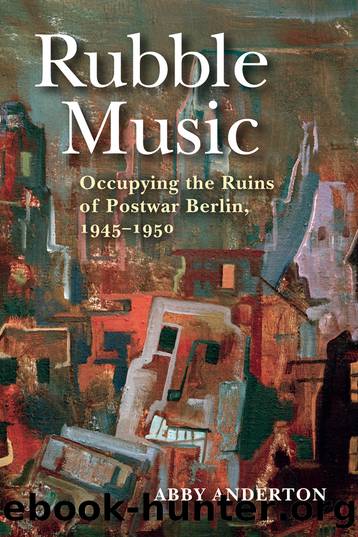Rubble Music by Anderton Abby;

Author:Anderton, Abby;
Language: eng
Format: epub
Publisher: Indiana University Press
Published: 2019-06-13T00:00:00+00:00
4
EMBODIED AND DISEMBODIED VOICES
Listening to Sonic Ruins
AS HENRY GLUSKI FLEW OVER BERLIN BEFORE LANDING at Tempelhof Airport in August 1945, he could scarcely believe the cityscape he witnessed. The ruins stretched as far as he could seeâmonuments to carpet-bombing and the violent street fighting of the warâs final weeks. Nineteen-year-old Gluski had just accepted a broadcasting position with Berlinâs American Forces Network (AFN), the radio station of the American military government designed for American GIs stationed in Berlin. Because he was the youngest and most inexperienced, Gluski was given the radio programs no one else wanted to moderate. His assignments included the early, early morning show and the weekly Quadripartite Symphony Hour. He chose mostly nineteenth- and twentieth-century repertoireânamely, the works of Jewish composers, including Mahler and Mendelssohn, believing their music held reeducational value for any German listener who might be tuning in.1
In a city that more closely resembled a moonscape than a metropolis, radio provided a link to the outside world. As historian Monica Black writes of the rubbled landscape of 1945, âRuins and the graves of the dead had come to comprise the cityâs topography and become part of a new, postwar way of seeing.â2 Yet the war had also created a new postwar way of hearing, as the destruction left its imprint on the aurality of the city. Without walls, doors, windows, or roofs, the ruins allowed sound to travel from dwelling to dwelling without any impediment. Radio blurred the boundaries of musical/sonic publicness and privacy, to evoke Georgina Bornâs terms, as sound could now freely travel. Radio waves lacing through one ruin to another created what R. Murray Schafer has called schizophonia, or the confusion between sound happening in real time and its electroacoustic counterpart. As British officer George Clare recalled, âMy most striking first impression was not visual but aural: the muted echoes of a battered city.â3 Other visitors found the ruins even took on a melody of their own: âAmid the sour wreckage of a spotted city this music of a sweet and nostalgic nature was often to be heard,â4 Allied soldier Richard Brett-Smith noted in his memoir.
While much scholarship has focused on the visually arresting aspects of ruins, less attention has been paid to their sound. One did not just see the ruins; one also heard them. These âmusically imagined communities,â5 created and informed by postwar German radio, offer a window into the shared traumatic experiences of the air war. This chapter explores the tensions between ruin listening in the private and public spheres. The disembodied voice of the radio created a community of listeners while still dividing the listening public who had to choose between the American- and Soviet-supported stations. Yet radio heard in the privacy of oneâs home stood in sharp contrast to the proliferation of public concerts in the ruins throughout postwar Germany. As Berlin musicians returned to the bombed craters of their former venues to stage performances, these ruin concerts permitted ensembles to engage with notions of German suffering by reclaiming churches, palaces, and concert halls destroyed by Allied bombing.
Download
This site does not store any files on its server. We only index and link to content provided by other sites. Please contact the content providers to delete copyright contents if any and email us, we'll remove relevant links or contents immediately.
The Goal (Off-Campus #4) by Elle Kennedy(12429)
Kathy Andrews Collection by Kathy Andrews(10516)
Diary of a Player by Brad Paisley(6866)
What Does This Button Do? by Bruce Dickinson(5525)
Assassin’s Fate by Robin Hobb(5236)
Big Little Lies by Liane Moriarty(4879)
Pale Blue Dot by Carl Sagan(4001)
Sticky Fingers by Joe Hagan(3454)
The Heroin Diaries by Nikki Sixx(2930)
The Death of the Heart by Elizabeth Bowen(2901)
Beneath These Shadows by Meghan March(2718)
The Help by Kathryn Stockett(2702)
Confessions of a Video Vixen by Karrine Steffans(2672)
How Music Works by David Byrne(2524)
Jam by Jam (epub)(2486)
Harry Potter 4 - Harry Potter and The Goblet of Fire by J.K.Rowling(2416)
Strange Fascination: David Bowie: The Definitive Story by David Buckley(2367)
Petty: The Biography by Warren Zanes(2236)
Darker Than the Deepest Sea by Trevor Dann(2206)
